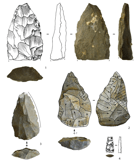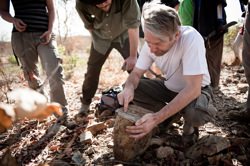CHronology of Rapid Climatic changes and Human adaptation in West Africa (CHeRCHA)
Project scope
The Palaeolithic and the transition to the Neolithic in West Africa remain poorly known compare to other African regions. Indeed, there are only a few well stratified and well dated archaeological assemblages: most of the known sites are surface deposits and/or are difficult to date with the radiocarbon method because of the poor preservation of the organic materials. The spatial and temporal resolution for the palaeo-environmental data is also very poor: most climatic and environmental models rely on distant data issued from a few studies of marine cores and Saharan lakes. Consequently, this huge part of the African continent is usually forgotten when archaeological syntheses are proposed, and its role in the debates on human evolution is under-estimated.
In the last decade, projects have emerged which attempt to correct this research bias. In particular, the study of the Yamé River valley (Dogon Plateau) in Mali, conducted within the “Palaeo-environment and Human Population in Africa” project –directed by E. Huysecom- has connected the local palaeo-environmental information to the well preserved cultural remains identified in this sequence, that was dated by luminescence and radiocarbon methods to the Upper Pleistocene and Holocene. The chronological data demonstrated that the numerous and various lithic assemblages succeeded on a relatively short time, what suggested that the region was visited by different populations with a rapid tempo during MIS 4 and 3. It was also shown that MIS2 corresponds to a sedimentary hiatus in the stratigraphic sequence. But how far can these patterns be extended to other West African regions? What is the temporality of the cultural changes, of the population dynamics and of the environmental changes in other areas/environments? And how general is the MIS2 hiatus in West Africa? The goal of this project is to answer these questions through the study of another West African region: the Falémé Valley, East of Senegal.

A research project funded by the Swiss National Science Foundation and ANR (grant 100019E_164071, Applicant in Switzerland Prof Eric Huysecom)
Internal collaborators
External collaborators
- Hajdas Irka Labor für Ionenstrahlphysik (ETH Zürich)
- Sarah Davidoux (Laboratoire de Géographie Physique (LGP)-UMR CNRS 8591 et Université de Paris Est)
- Aline Garnier (Laboratoire de Géographie Physique (LGP)-UMR CNRS 8591 et Université de Paris Est Créteil)
- Lespez Laurent (Laboratoire de Géographie Physique UMR 8591 CNRS Université Paris 1 - Panthéon-Sorbonne)
- Fatima Mokadem (Laboratoire de Géographie Physique (LGP)-UMR CNRS 8591)
- Clément Virmoux (Laboratoire de Géographie Physique (LGP)-UMR CNRS 8591)
- Michel Rasse (Université de Lyon 2, Maison de l’Orient et de la Méditerranée, Laboratoire Archéorient)
- Chantal Tribolo (IRAMAT-CRP2A, UMR 5060, CNRS, Université Bordeaux-Montaigne)
- Norbert Mercier(IRAMAT-CRP2A, UMR 5060, CNRS, Université Bordeaux-Montaigne)
- Brice Lebrun (IRAMAT-CRP2A, UMR 5060, CNRS, Université Bordeaux-Montaigne)

